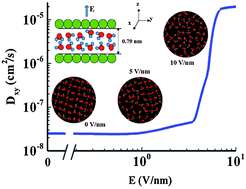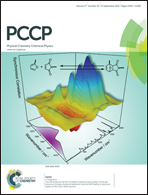Surface effect on the electromelting behavior of nanoconfined water†
Abstract
Electric field induced phase transitions of confined water have an important role in cryopreservation and electrocrystallization. In this study, the structural and dynamical properties of nano-confined water in nano-slit pores under the influence of an electric field varying from 0 to 10 V nm−1 are investigated under ambient conditions using molecular dynamics simulations. In order to replicate the nature of different materials, a systematic approach is adopted, including pore-size and lattice constant variations in different lattice arrangements viz., triangular, square and hexagonal, with hydrophilic and hydrophobic surface–fluid interactions. The structural behavior of water is investigated using radial distribution functions, bond order parameters and hydrogen bond calculations; the dynamical properties are analyzed using lateral and rotational diffusivity calculations. The lateral diffusivity with increasing electric field E increases by order(s) of magnitude during electromelting. The pore-size, lattice constant, lattice arrangement and hydrophobic/hydrophilic nature of the pore surface strongly influence the electromelting behavior for E ≤ ∼7 V nm−1. Higher values of lattice constants and/or hydrophobic pores enhance the electromelting behavior of nanoconfined water.


 Please wait while we load your content...
Please wait while we load your content...